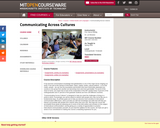
In an increasingly interconnected world, communicating across cultures is a crucial skill in the international networks of business, science, and technology. Subject examines a range of communication styles and techniques resulting from different cultural norms and traditions. It begins with a general theoretical framework and then moves into case studies. Topics include understanding the relationship between communication and culture, differences in verbal and non-verbal communication styles, barriers to intercultural communication, modes of specific cross-cultural communication activities (e.g. argumentation, negotiation, conflict resolution) and intercultural adjustment. Case studies explore specific ways of communicating in Asian and European cultures. Graduate students are expected to complete additional assignments. Taught in English.It has become commonplace knowledge that globalization is one of the major forces shaping our world. If we look at the spread of information, ideas, capital, media, cultural artifacts--or for that matter, people--we can see the boundaries and borders that have historically separated one country or one group from another are becoming more and more permeable. For proof of this close to home, you need only to look at the composition of the MIT student body: 8 percent of the undergraduates and 37 percent of the graduate students are from 109 different countries. "Communicating Across Cultures" is designed to help you meet the challenges of living in a world in which, increasingly, you will be asked to interact with people who may not be like you in fundamental ways. Its primary goals are to help you become more sensitive to intercultural communication differences, and to provide you with the knowledge and skills that will help you interact successfully with people from cultures other than your own. We hope the course will accomplish those goals by exposing you to some of the best writers and scholars on the subject of intercultural communication, and by giving you a variety of opportunities to practice intercultural communication yourself. As you read the syllabus for this course, we hope you get a sense of our commitment to making this course a rewarding experience for you.
- Subject:
- Arts and Humanities
- Cultural Studies
- English Language Arts
- Literature
- Material Type:
- Full Course
- Provider:
- M.I.T.
- Provider Set:
- M.I.T. OpenCourseWare
- Author:
- Bernd Breslow
- Lori
- Widdig
- Date Added:
- 01/01/2005


